在django的views中不论是用类方式还是用装饰器方式来使用rest框架,django_rest_frame实现权限管理都需要两个东西的配合: authentication_classes 和 permission_classes
# 方式1: 装饰器from rest_framework.decorators import api_view, authentication_classes, permission_classesfrom rest_framework.authentication import SessionAuthentication, BasicAuthenticationfrom rest_framework.permissions import AllowAnyfrom rest_framework.response import Response@api_view(["GET", ])@permission_classes([AllowAny,])@authentication_classes([SessionAuthentication, BasicAuthentication])def test_example(request): content = { 'user': unicode(request.user), # `django.contrib.auth.User` instance. 'auth': unicode(request.auth), # None } return Response(content)# ------------------------------------------------------------# 方式2: 类from rest_framework.authentication import SessionAuthentication, BasicAuthenticationfrom rest_framework.permissions import AllowAnyfrom rest_framework.response import Responsefrom rest_framework.views import APIViewclass ExampleView(APIView): authentication_classes = (SessionAuthentication, BasicAuthentication) permission_classes = (AllowAny,) def get(self, request, format=None): content = { 'user': unicode(request.user), # `django.contrib.auth.User` instance. 'auth': unicode(request.auth), # None } return Response(content) 上面给出的是权限配置的默认方案,写和不写没有区别。 rest框架有自己的settings文件 ,最原始的默认值都可以在里面找到:
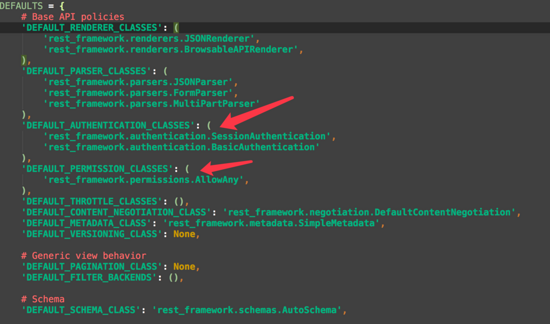
说道rest的settings文件,要覆盖其中的默认行为,特别是权限认证行为,我们只需要在 项目settings文件
中指定你自己的类即可:
REST_FRAMEWORK = { ... 'DEFAULT_AUTHENTICATION_CLASSES': ( 'your_authentication_class_path', ), ...} 在rest的settings文件中,获取属性时,会优先加载项目的settings文件中的设置,如果项目中没有的,才加载自己的默认设置:
初始化api_settings对象
api_settings = APISettings(None, DEFAULTS, IMPORT_STRINGS)
APISettings 类中获取属性时优先获取项目的settings文件中 REST_FRAMEWORK 对象的值,没有的再找自己的默认值
@propertydef user_settings(self): if not hasattr(self, '_user_settings'): # _user_settings默认为加载项目settings文件中的REST_FRAMEWORK对象 self._user_settings = getattr(settings, 'REST_FRAMEWORK', {}) return self._user_settingsdef __getattr__(self, attr): if attr not in self.defaults: raise AttributeError("Invalid API setting: '%s'" % attr) try: # Check if present in user settings # 优先加载user_settings,即项目的settings文件,没有就用默认 val = self.user_settings[attr] except KeyError: # Fall back to defaults val = self.defaults[attr] # Coerce import strings into classes if attr in self.import_strings: val = perform_import(val, attr) # Cache the result self._cached_attrs.add(attr) setattr(self, attr, val) return val 在rest中settings中,能自动检测 项目settings 的改变,并重新加载自己的配置文件:

权限管理原理浅析
rest框架是如何使用 authentication_classes 和 permission_classes ,并将二者配合起来进行权限管理的呢?
使用类方式实现的时候,我们都会直接或间接的使用到rest框架中的APIVIEW,在 urls.py 中使用该类的 as_view 方法来构建router
# views.pyfrom rest_framework.views import APIViewfrom rest_framework.permissions import IsAuthenticatedclass ExampleAPIView(APIView): permission_classes = (IsAuthenticated,) ... # -----------------------------from django.conf.urls import url, includefrom .views import ExampleAPIViewurlpatterns = [ url(r'^example/(?P<example_id>[-/w]+)/examples/?$', ExampleAPIView.as_view()),]
在我们调用 APIVIEW.as_view() 的时候,该类会调用父类的同名方法:
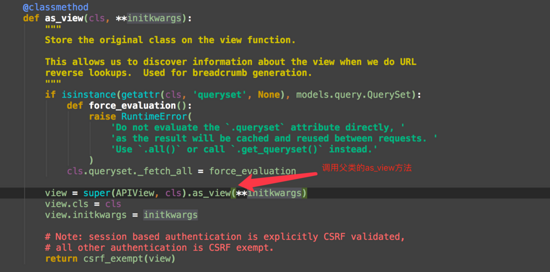
父类的同名方法中,调用了dispatch方法:
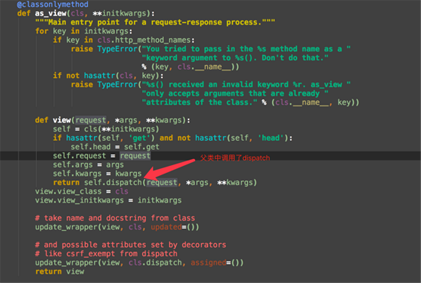
rest 重写 了该方法,在该方法中对requset做了一次服务端初始化(加入验证信息等)处理
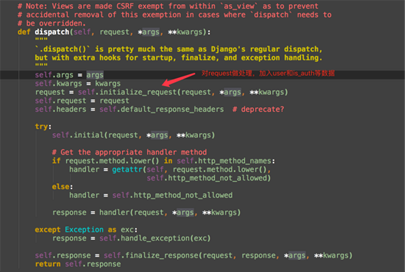
调用权限管理
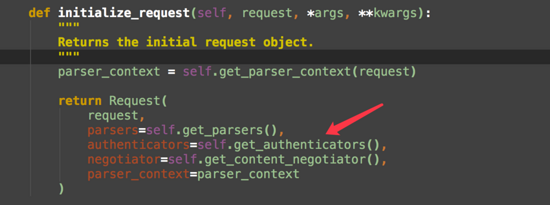
在权限管理中会使用默认的或是你指定的权限认证进行验证: 这里只是做验证并存储验证结果 ,这里操作完后authentication_classes的作用就完成了。验证结果会在后面指定的 permission_classes 中使用!
def get_authenticators(self): """ Instantiates and returns the list of authenticators that this view can use. """ return [auth() for auth in self.authentication_classes]
通过指定的permission_classes确定是否有当前接口的访问权限:
class IsAuthenticatedOrReadOnly(BasePermission): """ The request is authenticated as a user, or is a read-only request. """ def has_permission(self, request, view): return ( request.method in SAFE_METHODS or request.user and request.user.is_authenticated )
最后,不管有没有使用permission_classes来决定是否能访问,默认的或是你自己指定的authentication_classes都会执行并将权限结果放在request中!
以上就是本文的全部内容,希望对大家的学习有所帮助,也希望大家多多支持VEVB武林网。
注:相关教程知识阅读请移步到python教程频道。